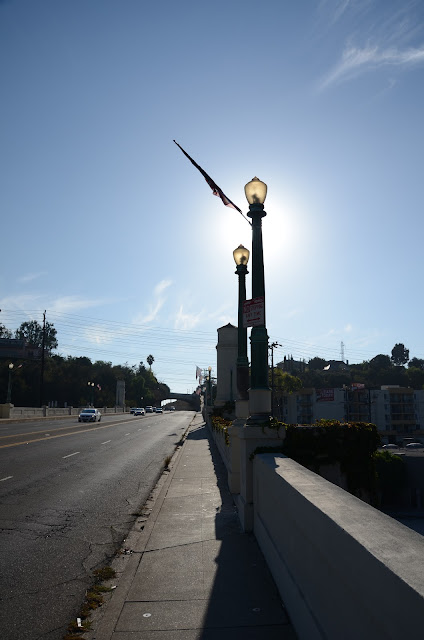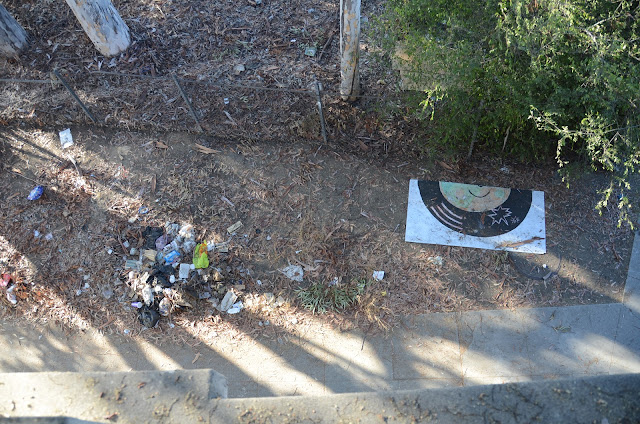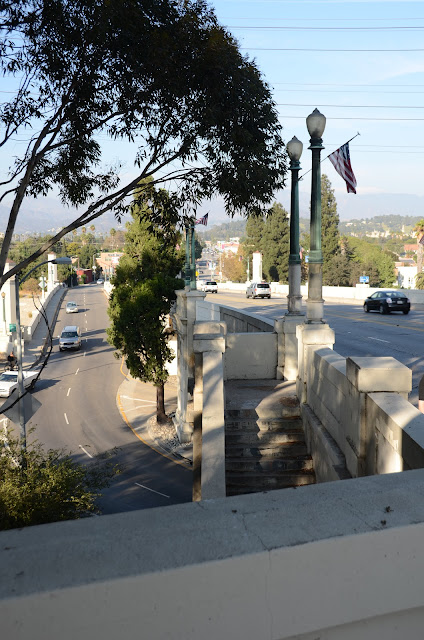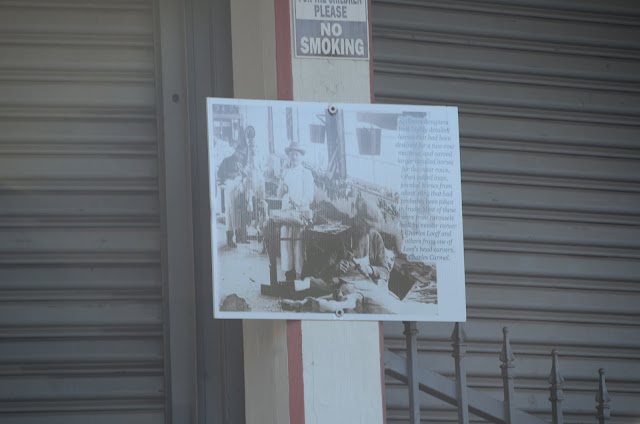Wednesday, October 31, 2012
Monday, October 29, 2012
Waverly Approach Glendale-Hyperion Viaduct, Los Angeles
This bridge looms over the 5 freeway like the shadowy apparition that it is. It's structural design is intimidating and beautiful at the same time. So much dark history haunts this bridge due to the deaths, abductions, and attacks that have occurred here. One such true recent terror is that of the "Hyperion Bridge Attacker" Others include stories of dark shadow figures looming on and around the bridges structure especially during the witching hours of the night. The reminiscent feel of old Hollywood and Golden Era are still embedded in this bridge, while a more modern dangerous flair combines into its new surface of lure.
I don't recommend walking over this bridge alone at night, especially if you are a young lady... I fear, too much of Los Angeles has many predators. If you decide to visit come in a group, and watch each others backs.
The Glendale-Hyperion Bridge is a concrete arch bridge viaduct in Atwater Village that spans the Los Angeles River and Interstate 5. The Hyperion Bridge was constructed in 1927 by vote of the citizens that lived in Atwater Village at the time, and was completed in February 1929. The bridge spans 400 feet over the Atwater section of the Los Angeles River and has 4 car lanes. The bridge has become more widely known because of existence of a small-scale replica of it at Disney California Adventure Park in Anaheim, California
Before the building of the Glendale-Hyperion Bridge there was a wooden bridge occupying where it now stands. The bridge that was built around 1910 served as the main entrance to Atwater Village. After a large flood in 1927 the old wooden bridge collapsed into the water.
In 1927, when Atwater Village was undergoing a large expansion in population, people needed to have an easier way of crossing the Los Angeles River. After the collapse of the original bridge Atwater needed a more convenient way of traveling to downtown Los Angeles. That year the citizens of Atwater Village, which was about 2,100 individuals, voted for the building of a new bridge to cross the Los Angeles River On March 27, 1927 construction began on the bridge. The original idea of building a bridge to cross the river was expanded to so the bridge would cross the pre-5 freeway. When the construction started, the city called the architectural designer, Merrill Butler. Merrill Butler bought 35,000 cubic yards of concrete and 6,000,000 pounds of reinforcing steel. They also drove about 1,500 wood and 3,200 concrete piles to support the piers and abutments. They also constructed 13 arches on the bridge. In total, Merrill Butler spent about $2,000,000 on the construction of the bridge. Butler decided to put in a section for trolley cars to cross the bridge along with cars. In September 1928 the Hyperion Bridge was officially opened.
In 1929 the Pacific Electric Railway constructed a line next to the Hyperion Bridge that would have Red Cars cross the Los Angeles River and down Glendale Boulevard. Up until 1959 the Red Cars would routinely cross the Los Angeles River next to the Hyperion Bridge. The line was shut down in 1959 in favor of Freeways. Today the concrete walls that held up the Red Car tracks still stand although the tracks have since been dismantled.
I don't recommend walking over this bridge alone at night, especially if you are a young lady... I fear, too much of Los Angeles has many predators. If you decide to visit come in a group, and watch each others backs.
The Glendale-Hyperion Bridge is a concrete arch bridge viaduct in Atwater Village that spans the Los Angeles River and Interstate 5. The Hyperion Bridge was constructed in 1927 by vote of the citizens that lived in Atwater Village at the time, and was completed in February 1929. The bridge spans 400 feet over the Atwater section of the Los Angeles River and has 4 car lanes. The bridge has become more widely known because of existence of a small-scale replica of it at Disney California Adventure Park in Anaheim, California
Before the building of the Glendale-Hyperion Bridge there was a wooden bridge occupying where it now stands. The bridge that was built around 1910 served as the main entrance to Atwater Village. After a large flood in 1927 the old wooden bridge collapsed into the water.
In 1927, when Atwater Village was undergoing a large expansion in population, people needed to have an easier way of crossing the Los Angeles River. After the collapse of the original bridge Atwater needed a more convenient way of traveling to downtown Los Angeles. That year the citizens of Atwater Village, which was about 2,100 individuals, voted for the building of a new bridge to cross the Los Angeles River On March 27, 1927 construction began on the bridge. The original idea of building a bridge to cross the river was expanded to so the bridge would cross the pre-5 freeway. When the construction started, the city called the architectural designer, Merrill Butler. Merrill Butler bought 35,000 cubic yards of concrete and 6,000,000 pounds of reinforcing steel. They also drove about 1,500 wood and 3,200 concrete piles to support the piers and abutments. They also constructed 13 arches on the bridge. In total, Merrill Butler spent about $2,000,000 on the construction of the bridge. Butler decided to put in a section for trolley cars to cross the bridge along with cars. In September 1928 the Hyperion Bridge was officially opened.
In 1929 the Pacific Electric Railway constructed a line next to the Hyperion Bridge that would have Red Cars cross the Los Angeles River and down Glendale Boulevard. Up until 1959 the Red Cars would routinely cross the Los Angeles River next to the Hyperion Bridge. The line was shut down in 1959 in favor of Freeways. Today the concrete walls that held up the Red Car tracks still stand although the tracks have since been dismantled.
Griffith Park, Merry-Go-Round, Los Angeles, Ca
Located
in Park Center between the Los Angeles Zoo and the Los Feliz park entrance,
the Griffith Park Merry-Go-Round has been a Los Angeles family attraction
for over five generations. Built in 1926 by the Spillman Engineering Company
and brought to Griffith Park in 1937, the Merry-Go-Round boasts 68 horses,
everyone a jumper. Each horse is finely carved with jewel-encrusted bridles,
detailed draped blankets and decorated with sunflowers and lion's heads.
A Stinson 165 Military Band Organ, reputed to be the largest band organ
accompanying a carousel on the West Coast, plays over 1500 selections
of marches and waltz music.
"In August, 1976 fire gutted the 1924 historic carousel at Lincoln
Park, destroying priceless carousel carvings, and spelling the end of an
era.
But not all was lost. Three horses from the 1924 masterpiece created
by the famous Spillman Engineering Company survived and
remain, installed on the Griffith Park Merry-Go-Round, the Lincoln
Park's sister carousel built just a few years later.
The Griffith Park Merry-Go-Round is a survivor in it's own right.
Built in 1926 by Spillman, it was originally part of the amusements at
Mission Beach, San Diego, and was moved to Griffith Park in 1937. The 68
intricately carved horses and the bucolic scenes on the canopy and
backdrop have seen better days, but the gently worn feeling is offset
beautifully by the extraordinary level of craftsmanship and the rare
opportunity to ride a vintage carousel surrounded by parkland.
According to signage at the carousel, some of the jeweled horses date
from as far back as 1887, and the carousel is said to have inspired a
young Walt Disney dreaming of Disneyland.
A vintage looking, but relatively new Stinson 165 Military Band Organ
cranks out festive tunes at an impressive volume and tempo, its organ
notes punctuated with drums, bells, and cymbal crashes. Like fairground
contraptions of old, the organ plays over 1500 selections of marches and
waltzes, and features animated figures on its decorated facade."-Atlas Obscura
Luis Alvarado, the Honorary Mayor of Griffith Park, reportedly encountered a ghost on two occasions by the merry go round. One night, while checking to help ensure all visitors had left the park at the sunset closing time, Alvarado watched as a man descended a staircase in the vicinity only to disappear when hitting the last step. Alvarado looked around to see if perhaps the man had disappeared into behind a tree, but could find no trace. A few nights later, Alvarado was spooked when the scene repeated itself.
Wednesday, October 24, 2012
The Castle Green, Pasadena, Ca
"There have been door knobs that turned when no one was in the hall, shadows passing under the doors, footsteps heard, faucets turned on in some apartments, heavy perfume smells and chains rattling. Some apartments are said to be more haunted than others."
I know an individual that lived in this building that is a credible witness to many paranormal incidences here in this structure. He lived on the top floor adjacent to the grand ballroom inside this maze of apartments. On many occasions he would hear a shuffled set of footsteps approaching his door, and then stopping outside his door. No sounds could be heard after. Also sometimes he would feel the steps and tweaking of floorboards come inside his room, when he went to look around; nobody could be found. He said this building is very haunted.
"The castle was built at the end of the 19th century as a retreat for rich Easterners, seeking a break from snow or a sun light cure of their Victorian maladies, fainting, fevers, "sadnesses" (the "depression" of the era) and prolonged invalid states. They came in droves by rail (trains), when rail was elegant and an adventure in itself. Some people were cured and eventually made their lives in California, but some people were not and despite its luxury, languished and died in Castle Green. In addition to the ill, those now permanently on vacation at Castle Green, we have tales of tragedy. A servant boy crushed in the downstairs laundry apparatus. One can still see the machinery that killed him today. Ironically they've placed the new laundry room at the site of the old, and people claim to hear whispers as they're permanent pressing their pants. We can't have washers and dryers in our own apartments (what were once the hotel suites), so everyone does their laundry downstairs. That's where the gossip takes place."- Rebecca "Tales of Castle Green. blogspot"
"The Castle Green Apartments that stand on Raymond Avenue in historic old town Pasadena were built in 1887 and officially opened to the public in 1889, however this wasn't the first portion of the Green empire. The first portion of the hotel complex that sits on the southwest corner of Raymond Avenue and Green Street with its hand cut granite facing, bay windows and retail space, was known as the Webster Hotel. Mr. Webster became nearly bankrupt while trying to finish his lavish hotel in time for its opening. It opened its doors to the public in the 1880s and was only open a few months before he sold it to Mr. Green, who finished the construction and changed its name to the Hotel Green. Green soon felt the need for another building as an annex to house the hundreds of guests who came to the resort town of Pasadena. The second building could be built near the railroad depot and property was available. Soon construction was underway and the six-story complex was built of wood. Pasadena was one of the most famous resort communities in Southern California during these times and a place for those suffering from tuberculosis. Doctors advised patients to go to dry and warmer climates and Pasadena became a boom town for snowbirds, those who desired a warmer climate during the harsh winters back east. The second building stood on the southeast corner of Raymond Avenue and Green Street and was a huge success when it opened in the mid 1870s. Green soon saw the advantage of building a more permanent residence within his hotel empire and a third building was designed and underway in 1887 as apartments, where those who wished to could rent for a week or a year or longer. The building has distinctive exterior elements in the Mediterranean Revival style and several interior spaces in the Moorish Revival style. It was decided that a bridge could be built over Raymond Avenue to annex the Castle Green Apartments or the new Hotel by visitors or long renting guests with easier access between the two buildings."
"The Castle Green Apartments were built of concrete and rebar for sturdier construction. Both had large ballrooms and dining rooms, a gentleman's smoking salon, a woman's salon, foyers, crystal chandeliers, a grand staircase in Cararra marble and the finest wrought and cast iron made for each of the buildings. Pasadena had 14 resort hotels by 1900, but the Hotel Green complex was one of the most famous and well patronized. Sitting across the street from Central Park with its rose gardens, fountains, paths, a zoo, lion and alligator and ostrich farms and a place for both locals and visitors to enjoy themselves. In the mid 1920s, the second hotel, built of wood, suffered a fire when a guest fell asleep with a lit cigar, catching the drapes and furniture on fire in the first floor smoking parlor. Evidence of the damage can still be seen on the square columns at the top where the plaster melted from the heat and the water from the fire hoses."
"The building was heavily damaged and a few people died. The building sat derelict until the 1935 Long Beach Earthquake, which brought more of it down; it was decided to tear the wooden building down completely. The only original portion sits on the corner facing Green Street and is used as the Christmas tree room for the decorating store Stats, which has owned the building since the 1960s. A tunnel runs from the old wooden Hotel Green under Raymond Avenue and connects to the earliest portion of the hotel and the apartments."
Some of the Information about Castle Green quoted from this blogspot http://talesofcastlegreen.blogspot.com/
I know an individual that lived in this building that is a credible witness to many paranormal incidences here in this structure. He lived on the top floor adjacent to the grand ballroom inside this maze of apartments. On many occasions he would hear a shuffled set of footsteps approaching his door, and then stopping outside his door. No sounds could be heard after. Also sometimes he would feel the steps and tweaking of floorboards come inside his room, when he went to look around; nobody could be found. He said this building is very haunted.
"The castle was built at the end of the 19th century as a retreat for rich Easterners, seeking a break from snow or a sun light cure of their Victorian maladies, fainting, fevers, "sadnesses" (the "depression" of the era) and prolonged invalid states. They came in droves by rail (trains), when rail was elegant and an adventure in itself. Some people were cured and eventually made their lives in California, but some people were not and despite its luxury, languished and died in Castle Green. In addition to the ill, those now permanently on vacation at Castle Green, we have tales of tragedy. A servant boy crushed in the downstairs laundry apparatus. One can still see the machinery that killed him today. Ironically they've placed the new laundry room at the site of the old, and people claim to hear whispers as they're permanent pressing their pants. We can't have washers and dryers in our own apartments (what were once the hotel suites), so everyone does their laundry downstairs. That's where the gossip takes place."- Rebecca "Tales of Castle Green. blogspot"
"The Castle Green Apartments that stand on Raymond Avenue in historic old town Pasadena were built in 1887 and officially opened to the public in 1889, however this wasn't the first portion of the Green empire. The first portion of the hotel complex that sits on the southwest corner of Raymond Avenue and Green Street with its hand cut granite facing, bay windows and retail space, was known as the Webster Hotel. Mr. Webster became nearly bankrupt while trying to finish his lavish hotel in time for its opening. It opened its doors to the public in the 1880s and was only open a few months before he sold it to Mr. Green, who finished the construction and changed its name to the Hotel Green. Green soon felt the need for another building as an annex to house the hundreds of guests who came to the resort town of Pasadena. The second building could be built near the railroad depot and property was available. Soon construction was underway and the six-story complex was built of wood. Pasadena was one of the most famous resort communities in Southern California during these times and a place for those suffering from tuberculosis. Doctors advised patients to go to dry and warmer climates and Pasadena became a boom town for snowbirds, those who desired a warmer climate during the harsh winters back east. The second building stood on the southeast corner of Raymond Avenue and Green Street and was a huge success when it opened in the mid 1870s. Green soon saw the advantage of building a more permanent residence within his hotel empire and a third building was designed and underway in 1887 as apartments, where those who wished to could rent for a week or a year or longer. The building has distinctive exterior elements in the Mediterranean Revival style and several interior spaces in the Moorish Revival style. It was decided that a bridge could be built over Raymond Avenue to annex the Castle Green Apartments or the new Hotel by visitors or long renting guests with easier access between the two buildings."
"The Castle Green Apartments were built of concrete and rebar for sturdier construction. Both had large ballrooms and dining rooms, a gentleman's smoking salon, a woman's salon, foyers, crystal chandeliers, a grand staircase in Cararra marble and the finest wrought and cast iron made for each of the buildings. Pasadena had 14 resort hotels by 1900, but the Hotel Green complex was one of the most famous and well patronized. Sitting across the street from Central Park with its rose gardens, fountains, paths, a zoo, lion and alligator and ostrich farms and a place for both locals and visitors to enjoy themselves. In the mid 1920s, the second hotel, built of wood, suffered a fire when a guest fell asleep with a lit cigar, catching the drapes and furniture on fire in the first floor smoking parlor. Evidence of the damage can still be seen on the square columns at the top where the plaster melted from the heat and the water from the fire hoses."
"The building was heavily damaged and a few people died. The building sat derelict until the 1935 Long Beach Earthquake, which brought more of it down; it was decided to tear the wooden building down completely. The only original portion sits on the corner facing Green Street and is used as the Christmas tree room for the decorating store Stats, which has owned the building since the 1960s. A tunnel runs from the old wooden Hotel Green under Raymond Avenue and connects to the earliest portion of the hotel and the apartments."
Some of the Information about Castle Green quoted from this blogspot http://talesofcastlegreen.blogspot.com/
Subscribe to:
Comments (Atom)


















































.jpg)






